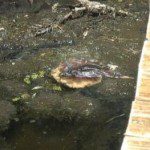The Florida Department of Environmental Protection (DEP) announced the adoption of the Lower St. Johns River (LSJR) Tributaries II Basin Management Action Plan (BMAP). The plan developed in partnership with the cities of Jacksonville Beach, Atlantic Beach, Neptune Beach, Naval Station Mayport, Duval County Health Department, Florida Department of Transportation, and JEA identifies actions to decrease fecal coliform bacteria in the LSJR Basin.
 The presence of fecal coliform in aquatic environments may indicate that the water has been contaminated with the fecal material of humans or other animals and could indicate a higher risk of pathogens being present in the water. Fecal coliform bacteria can enter rivers through direct discharge of waste from mammals and birds, agricultural and stormwater runoff, and from human sewage.
The presence of fecal coliform in aquatic environments may indicate that the water has been contaminated with the fecal material of humans or other animals and could indicate a higher risk of pathogens being present in the water. Fecal coliform bacteria can enter rivers through direct discharge of waste from mammals and birds, agricultural and stormwater runoff, and from human sewage.
DEP adopted water quality restoration targets, called Total Maximum Daily Loads (TMDLs), for 15 specific area waterbodies: Craig Creek, McCoy Creek, Williamson Creek, Fishing Creek, Deep Bottom Creek, Moncrief Creek, Blockhouse Creek, Hopkins Creek, Cormorant Branch, Wills Branch, Sherman Creek, Greenfield Creek, Pottsburg Creek, Upper Trout River, and Lower Trout River. The TMDLs establish the bacteria reductions needed to support recreation in these waters. The BMAP details the actions to reduce bacteria, a schedule for project implementation, and potential resources to accomplish the reductions.
“I am gratified to see that many local governments and stakeholders in the Lower St. Johns River basin are making serious commitments to clean up water pollution,” said DEP Interim Secretary Mimi Drew. “They deserve credit for implementing projects before this BMAP was even finished; and serve as a great model for other communities in the state.”
The LSJR Tributaries BMAP was developed through a collaborative partnership with local, regional, and state interests to address identified water quality problems. The local stakeholders identified more than 960 projects to achieve restoration in these waterbodies and will conduct continuing monitoring to ensure restoration occurs and identify additional sources of bacteria to prevent future problems.
Examples of significant project commitments include:
· City of Jacksonville – Phasing out septic tank in these 15 tributaries, inspecting private wastewater facilities, implementing capital improvement projects to reduce flooding, and identifying and removing illicit connections to the stormwater system.
· City of Atlantic Beach – Inspecting and maintaining sewer infrastructure and connecting more than 100 septic tanks to central sewer by 2013.
· Naval Station Mayport – Removing septic tanks, relining main sewer pipes and house connections with cured in-place piping, rehabilitating manholes and installing pet waste collection stations.
· City of Jacksonville Beach – Implementing numerous flood control projects near surface waters preventing the transport of pollution sources and implementing a water quality sampling program.
· City of Neptune Beach – Upgrading wastewater lift stations, replacing sewer main pipes, eliminating septic tanks, and hosting a “Walk the WBID (waterbody identification number)” event that includes field investigations and source sampling.
· Duval County Health Department – Inspecting septic tanks in seven BMAP WBIDs where systems have been identified as high risk for failure.
· Florida Department of Transportation – Maintaining DOT stormwater conveyances and identifying and removing illicit connections to the stormwater system.
· JEA – Upgrading sewer infrastructure and implementing preventive maintenance programs for the wastewater collection system.
According to Jacksonville Mayor John Peyton, “The stormwater utility fee funds many of the projects and all of the monitoring activities that will, over time, improve the health of our tributaries and consequently the St. Johns River. It is another component of the city’s commitment to restore the health of our waterways under the River Accord, a 10-year multi-agency initiative that charts a path of continual improvement for local agencies when it comes to water quality. We look forward to partnering with DEP and other stakeholders on the next phase of the BMAP process, when an additional 15 tributaries will be the focus.”
Mayor Harriet Pruette of Neptune Beach feels, “that the commitments of the stakeholders, who participated in the development of the BMAP, will lead to a healthier quality of life improvement for citizens who use and depend on our waterways.”
“Naval Station Mayport is committed to improving the quality of our creeks and tributaries by ongoing projects and outreach efforts geared to strengthen our environmental stewardship. What makes this so powerful is the fact that we have joined forces with so many other stakeholders and together we can accomplish much more than has been achievable in the past,” said Captain Aaron Bowman, Commanding Officer, Naval Station Mayport.
Citizens are encouraged to participate in improving water quality and eliminating bacteria sources by reporting sources of fecal coliforms. To report a failing septic tank, citizens should contact the Duval County Health Department at (904)253-1280. If citizens observe a sanitary sewer overflow or failing lift station, they should contact JEA at (904) 620-9921 or the City of Jacksonville CARE line at (904) 630-CITY.
To view the BMAP, visit www.dep.state.fl.us/water/watersheds/bmap.htm .
For more information about DEP’s water quality protection and restoration programs, visit: www.dep.state.fl.us/water/tmdl/index.htm.


